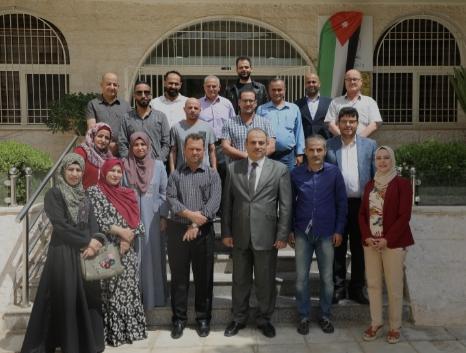NARC concluded A Training Course on Remote Sensing Monitoring for Wheat & Barley Production
Dr. Nizar Haddad, the Director General of the National Agricultural Research Center (NARC), patronized the closing ceremony of an advanced training course on “Monitoring wheat and barley cultivation using remote sensing geographical applications”, which was conducted by NARC as an activity of the Seeds’ Propagation Project.
Haddad said that His Majesty, King Abdullah II’s vision in the agriculture sector coinciding with the Jordan 76th Independence Day celebrations, necessarily requires everyone in the public and private sectors to consolidate modern research capabilities to introduce techniques that enable researchers to reinforce joint work; in collaboration with local and international partners, to come up with innovative solutions that promote wheat and barley production and increase productivity. Consequently, this will positively affect the agricultural sector, and enable researchers to enhance food security and achieve inclusive agricultural development.
He further added that the implementation of the Agricultural Innovation and Entrepreneurship Incubator contributes to capacity building and skills upgrading of agronomists and newly graduates, in both the public and private sectors, and this will familiarize them with innovative methods using remote sensing data to face the challenges of climate change.
Eng. Awad Al Ka’abneh, the “Seeds’ Propagation Project” coordinator said that this course is important demonstrating the use of modern technology to increase both quality and productivity, determine agricultural areas used, as well as, production estimation for the purpose of issuing certificates of origin for seeds. He added that the course targeted 12 agricultural engineers from various agricultural directorates in Jordan.
Eng. Lubna Al Mahasneh, head of the Geographical Information System Deptartment (GIS) at NARC, explicated that such training help survey and monitor the agricultural lands actually used for wheat and barley cultivation by using accurate remote sensing and space images analysis. In order to derive a plant cover indicator and verify modules and data derivatives.
On another note, Eng .Doa’a Abu Hammour stated that this data included information regarding origin certificates for farmers registered in the agricultural directorates. The data is classified according to the village, basin number, land record, and crop type, while emphasizing the necessity for using GIS and remote sensing technology, due to their ability to produce accurate readings for integrated geospatial and metadata, to manage them and produce maps.

